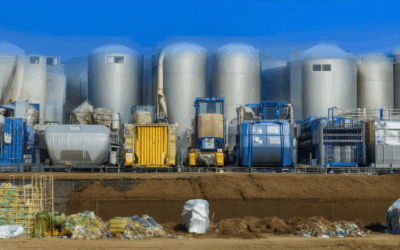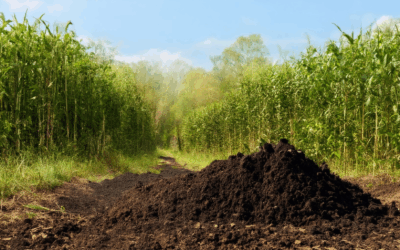Biochar, a versatile substance with roots in ancient agricultural practices, has emerged as a promising solution for modern water conservation efforts. Known for its ability to enhance soil structure and improve water retention, biochar acts as both a physical and chemical barrier, reducing runoff and promoting water infiltration. This eco-friendly approach not only supports sustainable farming but also offers innovative water treatment applications, making it a valuable tool for both agriculturalists and urban planners. By exploring its mechanisms, benefits, and potential drawbacks, this article delves into how biochar can play a pivotal role in achieving long-term water conservation goals while maintaining environmental integrity.
Key Takeaways
- Excessive biochar can lead to soil pH imbalances and nutrient competition, affecting plant health.
- Apply biochar at 5% by weight for optimal soil health and water conservation.
- Sustainable biochar production minimizes environmental impact and supports eco-friendly practices.
- Adjust biochar application frequency based on soil type, climate, and specific needs for effective water management.

Can Biochar Be Used in Water Treatment?
Biochar, a carbon-rich material derived from organic waste through pyrolysis, has emerged as a promising solution for water treatment due to its exceptional adsorption capacity. It effectively removes various contaminants from water, including heavy metals, pesticides, and pharmaceuticals, making it an ideal candidate for purifying drinking water.
Key Benefits of Biochar in Water Treatment
- Adsorption Capacity: Biochar exhibits high efficiency in capturing pollutants, significantly reducing contamination levels in water.
- Co-benefits: Using biochar in water treatment supports agricultural practices by improving soil fertility and promoting sustainable farming methods, thereby indirectly enhancing community health.
- Cost-effectiveness: As a low-cost alternative, biochar technology is particularly advantageous in developing regions, offering a practical solution to water purification challenges.
Limitations and Considerations
While biochar shows great potential, it has limitations. It is less effective in treating dissolved contaminants and requires proper activation to maximize its adsorption properties. Additionally, its effectiveness can vary depending on the specific water source and contaminants present.
Future Potential and Research
Research into biochar’s application in water treatment is ongoing, focusing on optimizing its production scale and exploring its potential for treating larger volumes of water. Collaboration between scientists, engineers, and policymakers will be crucial to unlocking its full potential in addressing global water scarcity and pollution issues.
For more information on biochar and its applications, visit our website at Pyrolysium and explore our resources on sustainable living and eco-friendly technologies.
Does Biochar Help Retain Water?
Biochar plays a significant role in enhancing water retention capabilities of soil, contributing to improved agricultural productivity and environmental sustainability.
When biochar is incorporated into soil, it increases the water retention capacity (WRC) by creating a more porous structure that traps and holds water molecules. This enhances soil moisture levels, reducing runoff and erosion, and promoting deeper root penetration. Studies indicate that biochar-treated soils exhibit improved hydraulic properties, allowing them to retain water longer and more effectively compared to untreated soils.
Additionally, biochar improves soil aggregation, which further reduces surface runoff and ensures that water remains available for plant roots. This benefit is particularly valuable in arid or semi-arid regions where water scarcity is a challenge. By reducing the frequency of irrigation needs, biochar helps conserve water resources while maintaining healthy plant growth.
Moreover, biochar’s ability to absorb and store water makes it an effective tool for filtering pollutants, further enhancing soil health and biodiversity. Farmers and gardeners can enhance their soil’s water retention properties by applying biochar in combination with compost or as a standalone soil amendment.
While biochar’s benefits are well-documented, it’s essential to consider application methods and soil types when implementing these practices. The effects of biochar on water retention may vary based on dosage and local conditions, emphasizing the importance of integrated soil management strategies.

Downsides of Biochar
Biochar, while offering numerous benefits, also presents several potential downsides:
- Environmental Emissions:** During the production process, biochar creation can release carbon dioxide (CO2) and volatile organic compounds (VOCs), contributing to air pollution unless the facility uses advanced emission control technologies.
- Toxin Presence:** Biochar may contain harmful substances such as dioxins, furans, and polycyclic aromatic hydrocarbons (PAHs), which can pose risks to human health and the environment if not properly filtered or managed.
- Carbon Sequestration vs. Waste Management:** While biochar acts as a carbon sink, its effectiveness depends on integrated waste management strategies. Over-reliance on biochar might divert resources from more efficient methods.
- Energy Requirements:** The production of biochar demands significant energy inputs, which can strain local resources if not sourced sustainably.
- Economic Barriers:** High initial costs and scalability challenges can hinder widespread adoption, particularly in regions with limited infrastructure and financial resources.
- Infrastructure Challenges:** Excessive use of biochar in certain applications may lead to blockages in pipes, machinery, or other systems, necessitating proper handling and distribution methods.

Can You Put Too Much Biochar in Soil?
Yes, applying too much biochar can harm your plants and disrupt soil health. Here’s why:
- Soil pH Imbalance: Biochar tends to increase soil acidity due to its production during pyrolysis. Over-application can elevate the pH beyond many plants’ preferred ranges, potentially stressing sensitive vegetation.
- Nutrient Competition: Excessive biochar may sequester essential nutrients like phosphorus and zinc, reducing their availability for plants and encouraging microbial competition, which can hinder plant growth.
- Soil Structure Issues: In large quantities, biochar can make soil too coarse, impeding root penetration and water infiltration, which are vital for plant survival and productivity.
For optimal results, consider applying biochar at recommended rates, typically around 5% by weight (approximately 50 kg per square meter for agricultural uses), and monitor your plants’ reactions to determine the suitable amount for your specific situation.
How Often Should You Add Biochar to Soil?
Your soil’s health and fertility depend on several factors, including the type of soil, application method, and regional climate. Here’s a guide to help you determine the optimal frequency for adding biochar:
- Initial Application:** Typically, you can apply biochar once every few years, especially if you’re aiming for long-term soil enhancement. A single application can provide sustained benefits, particularly when mixed thoroughly into the soil.
- Frequency of Reapplication:** The exact frequency depends on your specific needs and environment. Generally, annual applications may be beneficial, especially during planting seasons or before harvest, to maintain nutrient levels and promote healthy plant growth.
- Soil Type Considerations:** Different soils absorb biochar at varying rates. Sandy soils might require more frequent applications compared to loamy soils, which tend to hold nutrients better.
- Application Method:** Incorporating biochar deeply into the soil can slow its breakdown, extending its effectiveness. Surface applications may need more frequent reapplications to ensure consistent nutrient release.
- Climate Factors:** In regions with high rainfall or intense decomposition, biochar may break down faster, necessitating more regular applications. Conversely, arid climates may allow biochar to last longer due to reduced microbial activity.
- Composting and Amendments:** Applying biochar alongside compost or other organic amendments can enhance its effectiveness and reduce the frequency of future applications.
By considering these factors, you can tailor your biochar application schedule to suit your specific gardening or farming needs, ensuring optimal soil health and crop productivity.

Is Making Biochar Bad for the Environment?
The environmental impact of biochar production depends significantly on the raw materials used during its creation. Biochar is produced through pyrolysis, a process that converts organic waste into a carbon-rich material. While biochar can offer numerous benefits, such as improving soil health and reducing greenhouse gas emissions, its environmental effects are contingent upon the feedstock employed.
Positive Impacts of Biochar
- Enhances Soil Health : Biochar improves soil structure, water retention capacity, and nutrient availability, promoting plant growth and reducing nutrient runoff.
- Reduces Greenhouse Gases : By sequestering carbon, biochar helps mitigate climate change.
- Sustainable Resource Utilization : Converts organic waste into a valuable resource, contributing to waste management and sustainability efforts.
Potential Negative Impacts
- Contamination Risk : If produced from contaminated materials like treated wood or sewage sludge, biochar can introduce harmful substances into the soil, posing ecological risks.
- Energy Consumption : The energy-intensive pyrolysis process, often reliant on fossil fuels, contributes to its carbon footprint.
Production Considerations
- Feedstock Quality : Clean feedstocks, such as crop residues or manure, minimize environmental harm. Contaminated materials risk biochar’s benefits.
- Efficient Production : Optimize energy use and production methods to reduce environmental impact.
Alternatives and Best Practices
- Composting : A viable alternative that also enhances soil health through compost teas, though it lacks biochar’s contaminant-binding capabilities.
- Clean Production : Ensure biochar producers use clean feedstocks and efficient processes to maximize environmental benefits.
Conclusion
Making biochar isn’t inherently detrimental to the environment. Its impact is largely determined by the feedstock and production methods. When produced sustainably, biochar serves as a beneficial tool for environmental stewardship and agricultural productivity.




0 Comments